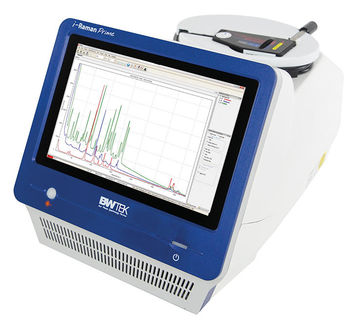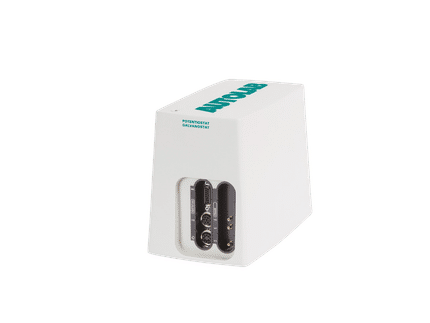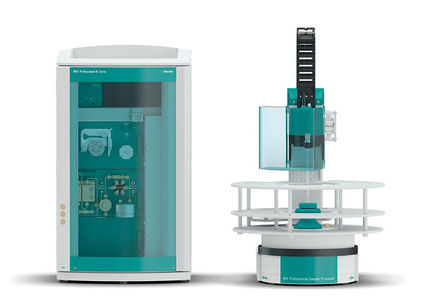To use all functions of this page, please activate cookies in your browser.
my.chemeurope.com
With an accout for my.chemeurope.com you can always see everything at a glance – and you can configure your own website and individual newsletter.
- My watch list
- My saved searches
- My saved topics
- My newsletter
Krypton difluoride
Krypton difluoride, KrF2, was the first compound of krypton discovered.[2] It is a volatile, colourless solid. The structure of the KrF2 molecule is linear, with Kr−F distances of 188.9 pm. It reacts with strong Lewis acids to form salts of the KrF+ and Kr2F3+ cations.[3] Product highlight
SynthesisKrypton difluoride can be synthesized using many different methods including electrical discharge, photochemical, irradiation, hot wire and proton bombardment. Electrical dischargeThe first method used to make krypton difluoride and the only one ever reported to produce krypton tetrafluoride was the electrical discharge method.[4] The electrical discharge method involves having 1:1 to 2:1 mixtures of F2 to Kr at a pressure of 40 to 60 torr and then arcing large amounts of energy between it.[5] Rates of almost 0.25g/h can be achieved.[6] The problem with this method is that it is unreliable with respect to yield. Proton BombardmentUsing proton bombardment for the production of KrF2 has a maximum production rate of about 1g/h.[7] This is achieved by bombarding mixtures of Kr and F2 with a proton beam that is operating at an energy level of 10MeV and at a temperature of about 133K.[8] It is a fast method of producing relatively large amounts of KrF2, it runs into difficulties in that it requires a source of α-particles which usually would come from a cyclotron.[9] PhotochemicalThe photochemical process for the production of KrF2 involves the use of UV light and can produce under ideal circumstances 1.22g/h.[10] The ideal wavelengths to use are in the range of 303-313nm.[11] It is important to note that harder UV radiation is detrimental to the production of KrF2.[12] In order to avoid the harder wavelengths, simply using Pyrex glass or Vycor or quartz will significantly increase yield because they all block harder UV light.[13] In a series of experiments performed by S. A Kinkead et. al, is was shown that a quartz insert (UV cut off of 170nm) produced on average 158mg/h, Vycor 7913 (UV cut off of 210nm) produced on average 204mg/h and Pyrex 7740 (UV cut off of 280nm) produced on average 507mg/h.[14] It is clear from these results that higher energy ultra violet light reduces the yield significantly. The ideal circumstances for the production KrF2 by a photochemical process appear to occur when Kr is a solid and Fluorine is a liquid which occur at 77K.[15] The biggest problem with this method is that is requires the handling of liquid F2 and the potential of it being released if it becomes over pressurized.[16] Hot WireThe hot wire method for the production of KrF2 involves having the krypton in a solid state with a hot wire running a few centimeters away from it as fluorine gas is then run past the wire.[17] The wire has a large current, causing it to reach temperatures around 680C.[18] This causes the fluorine gas to split into its radicals which then can react with the solid krypton.[19] Under ideal conditions, it has been known to reach a maximum yield of 6g/h.[20] In order to achieve optimal yields the gap between the wire and the solid krypton should be 1cm, giving rise to a temperature gradient of about 900C/cm.[21] The only major downside to this method is the amount of electricity that has to be passed through the wire thus making it dangerous if not properly set up.[22] Cystallographic MorphologiesKrypton difluoride can exist in one of two possible cystallographic morphologies: α-phase and β-phase. β-KrF2 generally exists at above -80C, while the α- KrF2 is more stable at lower temperatures.[23] The unit cell of α-KrF2 is body centred tetragonal. Related compounds
References
General reading
Categories: Fluorides | Krypton compounds |
|||||||||||||||||||||||||||||||||||||||
| This article is licensed under the GNU Free Documentation License. It uses material from the Wikipedia article "Krypton_difluoride". A list of authors is available in Wikipedia. | |||||||||||||||||||||||||||||||||||||||
- Bayer MaterialScience expands its distribution network for polycarbonates in Eastern Europe through the addition of ALBIS
- Lauterbach Verfahrenstechnik - Eggenstein, Alemanha
- von Nordenskjöld Verfahrenstechnik GmbH - Egmating, Germany
- Optinova Holding Ab - Mariehamn, Finlândia
- LED SpA - Aprilia, Itália







